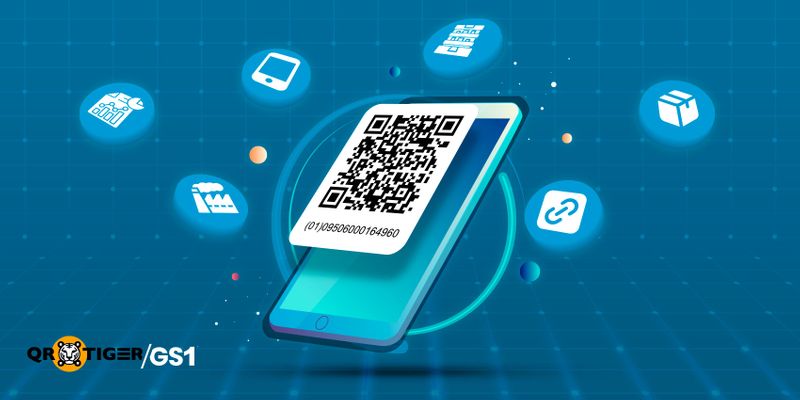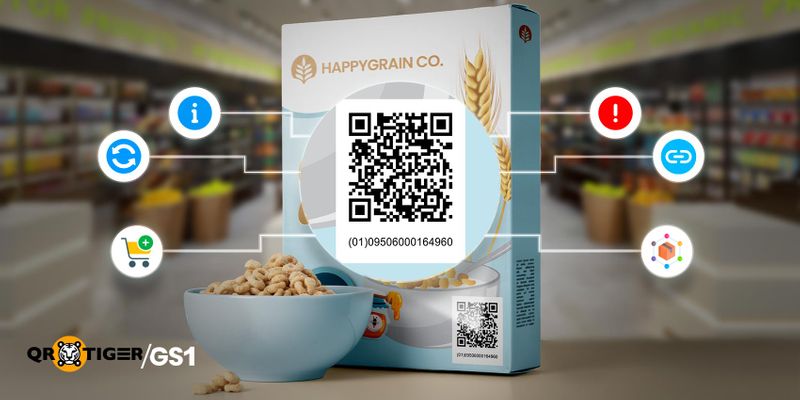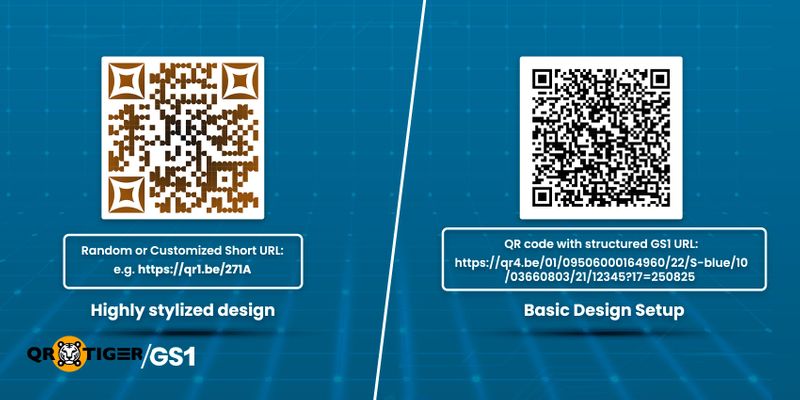Is a GS1 Digital Link QR Code a Dynamic QR?

QR codes are commonly classified as either static or dynamic. Static QR codes store fixed data such as ID or URL that can’t be modified once the code is generated. On the other hand, dynamic QR codes contain a redirect link that leads to editable content, allowing scan analytics, real-time updates, and personalized user experiences.
This difference plays a key role across industries where data integrity and information agility are essential.
A QR code powered by GS1 Digital URI is a dynamic solution that offers all the core functionalities of a standard dynamic QR code, while also incorporating GS1’s standardized product identification.
So, it makes the product scannable for point-of-sale systems while simultaneously facilitating dynamic redirection to updatable content (for example traceability info, marketing pages, or regulatory data).
Table of Contents
What Is a GS1 Digital Link QR Code?

Digital Link QR code is a next-generation barcode connecting a physical product to digital content using globally recognized GS1 standards.
Traditional barcodes only encode a product identifier, but these QR codes embed a structured, static URL that links directly to web-based data such as recall notices, user manuals, product details, sustainability certifications, and promotional content.
Scanning it via a smartphone or compatible scanner unlocks brand-controlled, real-time information driving traceability, transparency, and consumer engagement.
Global Trade Item Number (GTIN) is embedded within the URL using GS1’s standardized URI syntax, ensuring product recognition globally across supply chains and digital platforms.
The GS1 Digital Link structure also supports identifiers like serial numbers, batch numbers, and expiry dates for regulatory compliance and product authentication.
Built on open GS1 standards, a single QR code can handle tasks from point of sale (POS) scanning to cloud-based data access, no need for multiple barcodes.
The GS1 2D barcode is gaining momentum across industries. In retail, it accelerates checkouts and benefits consumers with instant product access with a simple scan. In supply chain and logistics, it facilitates detailed item tracking, simplifies recall processes, and boosts inventory accuracy.
With the global shift toward 2D barcodes, these QR codes are expected to become the universal standard for smart packaging by 2027.
Structured by standards, dynamic in function
A GS1 Digital Link QR code may appear like a standard printed symbol, but its capabilities go far beyond static data. Once printed, the QR code itself contains a fixed structure— a URL that encodes GS1 identifiers.
This structure and URL don’t change, ensuring consistency for point of sale (POS) systems, regulatory compliance, and inventory tracking.
Its real strength lies in its underlying architecture. These QR codes are powered by resolvers.
In the GS1 Digital URI infrastructure, the resolver is a gateway connecting the scannable code and relevant web content. It ensures that the user is directed to the correct online resource based on the scanned link.
Specifically, the resolver reads the GS1 identifiers in the URL inside the GS1 QR code. It then redirects to the matching online resource, depending on what the scanner app sends during the request.
Note that resolvers can dynamically adjust the destination based on context such as device type, location, or user role. This means that the printed code stays unchanged, but the experience it delivers can be updated.
This allows brands to update digital experiences without reprinting packaging, making it a scalable solution for traceability, engagement, and global compliance.
The dynamic nature of Digital Link URI conveys the right information to each user, offering consumers instant access to product insights while enabling brands to provide personalized content like offers or loyalty programs.
Resolvers can be set up to redirect users based on available context, like location, device type, time, or specific query parameters.
For example, a resolver might show local regulatory info, switch to a new campaign after a certain date, or display different content depending on whether the request came from a smartphone or a POS system.
Use cases:- Modifying destination links: Brands can update the resolver to redirect to new product pages, updated documentation, or promotional campaigns, without reprinting packaging.
- Region-specific content: A single QR code can serve different languages, regulatory info, or marketing offers based on the region it is scanned in.
- Consumer engagement: Scanning through a smartphone can redirect consumers to loyalty programs, how-to videos, or sustainability claims, whereas POS scanners retrieve GTIN data for checkout.
- Batch info traceability: Resolvers can deliver expiry details or recall notices based on embedded serial or batch numbers.
These QR codes are printed once but can function dynamically. That makes them well-suited for traceability, interactive packaging, and multi-channel consumer engagement.
How GS1 QR Codes Are Tracked Across Devices?
These QR codes are scanned and tracked in different environments.
Let’s break it down further to ensure clarity:
1. Smartphone scans (consumer/public-facing)
Smartphones treat GS1 Digital URI QR codes as clickable URLs. When scanned, they access the resolver URL (e.g., https://id.gs1.org/01/09506000134352).
If no additional query parameters are sent, the resolver applies its default redirect rule, which leads to a brand-defined destination. This could be a product page, documentation, or any link the brand configures.
A scan alone does not enable tracking. Data is only recorded if the user actually visits the link encoded in the QR code.
Once the link is accessed, the resolver logs each scan as a URL access, enabling analytics tools (e.g., Google Analytics, custom dashboards) to capture:
- Timestamp
- IP address
- Device type
- Geolocation
These logs provide real-time consumer engagement metrics, such as scan frequency (indicating number of URL accesses), regional interest, and device usage.
More precise location data (like GPS) can only be collected if the destination website or app requests it after the user opens the link, and the user must give permission, as required by GDPR and similar privacy laws.
If the resolver is misconfigured or unavailable, scans may not be recorded, making resolver uptime critical for tracking accuracy.
2. Industrial barcode scanners (supply chain/internal)
In operational settings like retail, factories, and warehouses, the scanners do not open the URL. They extract and transmit only the raw data, such as GTIN (Global Trade Item Number), Batch/Lot Number, Serial Number, to local systems like POS (Point of Sale), ERP (Enterprise Resource Planning), and WMS (Warehouse Management System).
Logging is handled by these internal systems. If set up correctly, they can record:
- What was scanned
- Where it was scanned (e.g., Dock 3 or Warehouse A)
- When it was scanned (timestamp)
- Who scanned it (user ID or device ID)
In simple terms:
Smartphone visits are tracked via the link in the QR code.
Industrial scanners track by reading the embedded GS1 data and passing it to internal systems.
Key differences summarized
Aspect | Smartphone Scans | Barcode Scanner Scans |
Data Flow | Hits a web URL via the resolver | Sends raw data to the local system |
Tracking Method | Web analytics (GA, resolver logs) | Internal logs (ERP, WMS, POS) |
Internet Required? | Yes | No |
Primary Use Case | Consumer engagement, marketing | Supply chain operations |
QR codes use the GS1 Digital URI standard, enabling dynamic functionality along with structured product identification for reliable traceability and data access. Try out our GS1 QR code generator and test the QR code on one of your products to see how it works for product tracking and consumer engagement in your business.
Standard Dynamic QR codes vs GS1 Digital Link QR code
 s
sThe key distinction lies in standardization, only GS1 Digital URI QR codes conform to GS1 global barcode standards, making them suitable for regulated industries and supply chain integration.
Standard dynamic QR codes are generated flexibly, often using random or custom short URLs.
It is possible to create a GS1 Digital Link using a standard dynamic QR code generator, but the platform must allow full control over the URL, and the user must manually follow the correct GS1 syntax. Most platforms don’t validate GS1 structure or identifiers, so the result may not be standards compliant.
If done this way, the following are required:
- A correct GS1 Digital Link URI, following GS1’s syntax rules
- An understanding of GS1 Application Identifiers (AIs)
- Proper URL encoding of all values and their format
- Full domain ownership or access if not using a GS1 resolver
- Optional: Manual setup of analytics and redirection logic
- Awareness that most generic platforms enforce no syntax validation
So, while it’s technically possible, there are too many chances for error.
It’s far better to use a fully functional and user-friendly GS1 Digital Link QR code generator that handles structure, validation, and redirection correctly.
In short, a GS1-resolvable URL is not just dynamic, it’s standardized, making it the preferred QR solution for both consumer engagement and enterprise-grade compliance.
The table below clarifies the differences:
Feature | GS1 Digital Link QR code | Dynamic QR code |
Can change destination | Yes | Yes |
Trackable? | Yes | Yes |
Data inside QR? | Follows GS1 Digital Link Standard | Short Random or Customized characters |
Used in Product Identification? | Yes | No |
Why do GS1 standards matter in product QR codes?
GS1 is a global, neutral, not-for-profit organization that develops and maintains the most widely used supply chain standards. It aims to support data capture, standardized identification, and data sharing across industries and geographies. This is made possible by embedding identifiers in barcodes, RFID tags, and GS1-resolvable URIs.
This interoperability plays a key role in enabling global trade, meeting regulatory compliance, and supporting digital transformation through scalable, standardized data exchange.
Role in digital transformation
The GS1 Digital URI standard is a key driver of digital transformation. It upgrades traditional barcodes into web-enabled gateways, connecting physical products to digital content. It embeds GS1 identifiers into a structured URL that allows:
Supply chain systems and retailers to extract batch data and GTINs for inventory, traceability, and compliance.
Consumers can access product info, promotions, and authenticity checks.
Sectors where GS1 compliance is essential
GS1 compliance is necessary in the following industries where safety, traceability, and accuracy are non-negotiable:
Sectors | Application of GS1 Compliance |
Retail | POS scanning, consumer engagement, inventory management, and product recalls |
Logistics | Global trade, shipment tracking, and warehouse automation |
Pharma | Maintaining regulatory compliance (for example, EU FMD (Falsified Medicines Directive)), serialization, and anti-counterfeiting |
Healthcare | Medical device traceability, patient safety, and electronic leaflets |
Food & Beverage | Origin tracking, sustainability claims, allergen info, and recall execution |
Conclusion
QR codes powered by GS1 represent hybrid functionality combining the fixed, standardized structure of traditional barcodes with the functionality of modern dynamic QR codes. The embedded data is unchangeable once printed, but resolvers facilitate flexible redirection, comprehensive scan tracking, and tailored content delivery.
DISCLAIMER: We acknowledge that GS1, as well as the materials, proprietary items, and all related patents, copyright, trademark, and other intellectual property (collectively, “intellectual property”) relating to its use, are the property of GS1 Global, and that our use of the same shall be in accordance with the conditions provided by GS1 Global.




